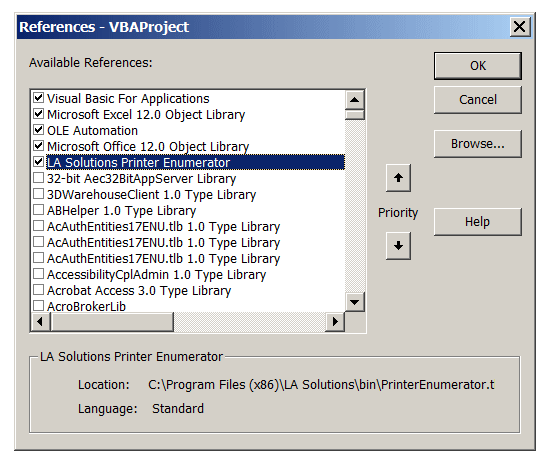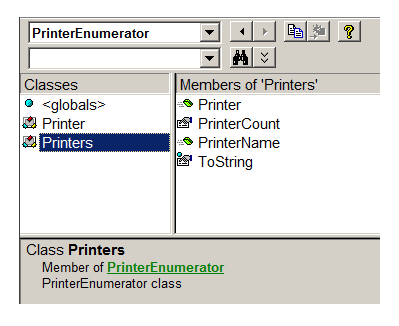This article describes an ActiveX component that helps programmers to enumerate Windows printers. It's primarily aimed at Visual Basic for Applications (VBA) developers whose VBA implementation contains no built-in way to ask Windows about the printers available to a computer.
Some VBA implementation includes printer tools (Excel VBA, for example) but others lack them, presumably because they are not part of the Microsoft Windows VBA Toolkit provided to OEMs. An example of a VBA that omits printers altogether is Bentley Systems MicroStation VBA.
Q Here are some questions about printers and printer enumeration posted by MicroStation VBA developers on the MicroStation Programming Forum …
- How do I enumerate Windows printers?
- How do I let a user choose a printer?
A A solution to those questions is our Printer Enumerator ActiveX DLL. It is a COM server which a VBA programmer can use to query printers attached to a computer. The Printer Enumerator is freeware.
Printer Enumerator
The Printer Enumerator is a DLL, also known as an ActiveX component or COM server. It provides a COM interface, which a VBA programmer can discover simply by referencing the DLL in her VBA Interactive Development Environment (IDE).
The primary interface is the Printers API.
It tells you how many printers are available and the name of each printer.
Create a Printers object like this …
Dim oPrinters As PrinterEnumerator.Printers Set oPrinters = New PrinterEnumerator.Printers
Another interface is the Printer class.
Obtain a Printer object from Printers like this …
Dim oPrinters As PrinterEnumerator.Printers
Set oPrinters = New PrinterEnumerator.Printers
Dim oPrinter As PrinterEnumerator.Printer
Set oPrinter = oPrinters.Printer ("HP DeskJet")
If a printer having the designated name does not exist then Printer will be Nothing.
You can't create a Printer object in any other way.
In other words, the following is not possible …
Dim oPrinter As PrinterEnumerator.Printer
Set oPrinter = New PrinterEnumerator.Printer ' Not possible
Example VBA Code
Before you can use a COM component such as the Printer Enumerator you must create a reference to it. Create a reference in the VBA IDE from the Tools|References menu …

If you want to examine the interface in detail, press key F2 to pop the VBA object browser …

The following code is taken from the Excel VBA example delivered with Printer Enumerator …
Public Sub Main()
Dim oPrinters As New PrinterEnumerator.Printers
Debug.Print oPrinters.ToString
Dim nPrinters As Long
nPrinters = oPrinters.PrinterCount
Debug.Print "There are " & CStr(nPrinters) & " printers"
Dim i As Long
For i = 0 To nPrinters - 1
Dim printerName As String
printerName = oPrinters.printerName(i)
Debug.Print "Printer [" & CStr(i + 1) & "] '" & printerName & "'"
Dim oPrinter As PrinterEnumerator.Printer
Set oPrinter = oPrinters.Printer(printerName)
Dim nPaperSizes As Long
nPaperSizes = oPrinter.PaperSizeCount
Debug.Print "Printer '" & oPrinter.Name & "' has " & CStr(nPaperSizes) & " paper sizes"
Dim size As Long
For size = 0 To nPaperSizes - 1
Debug.Print "Size [" & CStr(size) & "] name '" & _
oPrinter.PaperName(size) & _
"' kind '" & oPrinter.PaperKind(size) & "'"
Next size
Next i
End Sub
Questions
Post questions about MicroStation programming to the MicroStation Programming Forum.
Download the Printer Enumerator ActiveX DLL

Note: We developed the Printer Enumerator, several years ago, for a 32-bit client. At the time of writing, nobody has asked for a 64-bit version. If you're interested in a 64-bit version of the Printer Enumerator for use, say, with MicroStation CONNECT or Excel 64-bit, then contact us.
The Printer Enumerator ActiveX Component is a Windows DLL (PrinterEnumerator.dll).
The installer in the ZIP package
copies the DLL to your Program Files folder
and registers the
COM interface with Windows.
After installation you should find the file PrinterEnumerator.dll in folder
C:\Program Files\LA Solutions\bin
After installation you should find the example Excel file PrinterTester.xlsm in folder
C:\Program Data\LA Solutions\PrinterEnumerator
Note: You'll need to have installed the 64-bit version of Microsoft Excel to be compatible with the 64-bit PrinterEnumerator.dll.
